#transplanting
Text



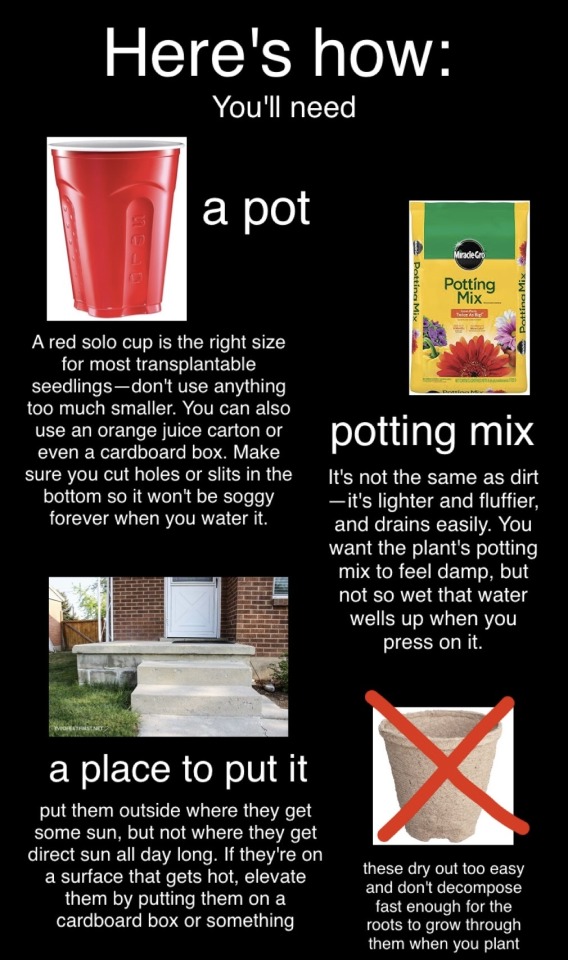



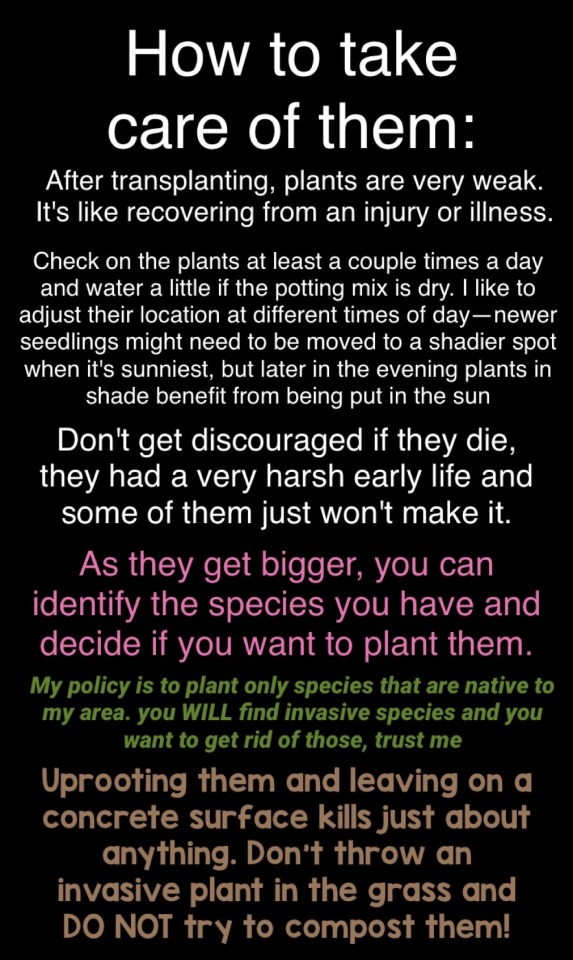

as promised, the transplanting tutorial
most sources make transplanting sound incredibly difficult, but transplanting young seedlings from areas with sparse dirt, like a driveway or roadside, is actually incredibly easy and can get you some great stuff. Once I worked out the method, i've had a very high survival rate
it took me like a month of trial and error to figure this out so you don't have to.
Feel free to repost, no need for credit
28K notes
·
View notes
Note
Hello

If I take this moss from a parking lot and carry it tenderly home and lay it gently among the feeler roots of my monstera and promise to love it forever will it love me back or will it be sad?
Hello, that is some lovely moss!! I think if you do that it will love you back <3
Especially if you carefully lift it up in one piece (a butter knife or something similar can help to gently nudge it), brush off any hitchhikers (bugs, etc), and make sure that the top layer of your potting soil is loose and moist so the moss can latch onto it and stay hydrated. Should pair well with the monstera since they both like shade :) Also, if you do the transplant, would love to see a pic of it in its new home!
#ask#asks for me!!!#this is such a lovely ask#definitely here for the moss love!#moss#mosscore#transplanting#plant#plantcore
38 notes
·
View notes
Text

4/7/24 ~ transplanted some stuff that was left over in my seed tray that I neglected 🥲 They aren’t too happy right now 🙃🌱
Some of them are Tamarillos. Anyone familiar with those? It was a random purchase for me 😋
#tamarillo#transplanting#starting seeds#tomato farming#pepper garden#growing peppers#sustainable gardening#edible landscaping#permaculture#indoor garden#container gardening#vegetable gardening#growing food#plant life#plant mom#veganuary#grow organic#grow food not lawns
8 notes
·
View notes
Text
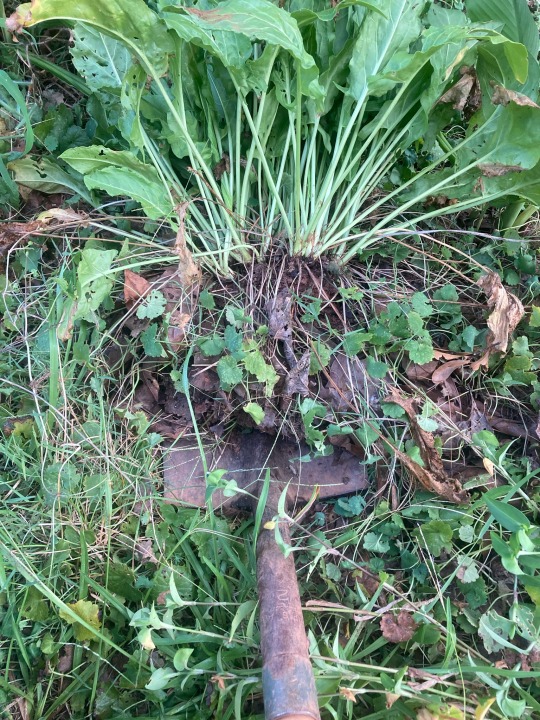
One of the bitters in our summer salads is sorrel. It’s a calm member of the Knotweed family and shares lots of love with my favorite summertime cover crop buckwheat. It’s also the cousin to rhubarb.
The photo shows how I was transplanting sorrel yesterday.
#sorrel#knotweed family#atlanta urban ag#food systems#food access#herbs#compost#transplanting#food sovereignty#soil food web#healthy soil#drought tolerant#food culture#simple food small farmz air bnb#maurice small
13 notes
·
View notes
Text
The plants are all replanted and in a sunny window. Started some seeds not to long ago to make up for all the lost plants. Trying out some seed started bags to see how if they are any good. Not sure how biodegradable they will be because they seem like cloth but it’s worth a try since everything this season will be an experiment.

#gardening#garden#gardenlife#indoorgarden#indoorplants#plants#widnowplants#plant photography#plantphotos#transplant#transplanting#seedlings#nature
2 notes
·
View notes
Video
youtube
Repotting a large Root Bound Dendrobium Orchid
#youtube#greenhouse#growing#gardening#repotting#orchid#dendrobium#transplanting#plant#plant care#how to#diy
10 notes
·
View notes
Text
Our 2023 garden: transplanting eggplants, onions and tomatoes

View On WordPress
#2023 garden#growing food#Little Finger eggplant#Red of Florence onions#self sufficiency#Spoon tomatoes#transplanting#vegetable gardening
2 notes
·
View notes
Photo

Here are all the rescued plants transplanted into slightly bigger pots! Thank you to everyone who responded about the name of the pink flowered plant, I do think it’s Madagascar Periwinkle, and from what I’ve seen online it can grow into a huge big plant! All of the plants needed pruning, and had very tightly-grown root system, they’ve been in tiny pots for too long, I hope they recover.
I also found this houseleek someone threw off of their balcony?? It was on the street?? It had a lot of dry leaves, so presumably the person thought it was drying off and dying and just threw it away. But the plant was just struggling with heat and had to let some of the leaves go, she was perfectly alive, and I’ll make sure it stays that way.
Finally having more houseplants! It makes me happy to have some that are always in flower. Isn’t that a bright future? There will always be flowers in my home.
#houseplants#houseleek#madagascar periwinkle#begonia#transplanting#plant care#i couldn't give them bigger pots#because most of these are not frost hardy#and will have to be on my kitchen window during the winter#so only small pots like this can fit there#but they're still larger than what the plants had to work with before#so it's an improvement#if they fill in by spring#i'll transplant them again
17 notes
·
View notes
Text
Step-by-Step Guide: How to Germinate Herbs from Seeds for an Indoor Culinary Herb Garden
Starting an indoor herb garden from seed can be a fun and rewarding way to ensure a fresh supply of herbs for your cooking needs. Germinating herbs from seeds is a simple process, and with the right techniques, you can easily grow a variety of herbs in your indoor culinary herb garden. Here are some tips on how to germinate herbs from seeds for an indoor herb garden:
1. Choose the right seeds:…

View On WordPress
#germination#grow from seeds#growing#herbs#indoor herb gardening#indoor herbs#Light#moisture#potting mix#seeds#soil#transplanting#warmth
2 notes
·
View notes
Text
Foraging and Cultivation: How to Eat the Weeds Without Bugging the Bees

All photos in this article are taken by me. You can view my gallery here.
Here's some information for adventurous eaters.
Some people are understandably wary about eating foods that they can't get from a grocery store. Between concerns about animal feces and pesticides to stories about mushroom poisoning and death, we can all agree that it's not wise to just go outside, grab a healthy-looking berry, and shove it down your gullet. There is a right way to forage, and as a foraging veteran, I'm going to take you through some of the most important information you need to start your own foraging journey.
❁❀✿✾
The Universal Edibility Test
The first, and maybe most important, thing I want to talk about is, of course, how to avoid poisoning or death. Even if what you eat is not inherently poisonous, you can also be allergic to things it would never occur to a doctor to test you for. So, let's discuss best practices for gathering wild plants to prevent injury/death. Luckily, those who came before you have developed a great process for not getting killed while foraging.
Note that this is NOT a safe method for testing the edibility of mushrooms, which are much more difficult to identify and require a lot of study and experience. I may write another article regarding mushroom foraging at a later date, but it's very dangerous so for the purposes of this article, we are only going to discuss plants.
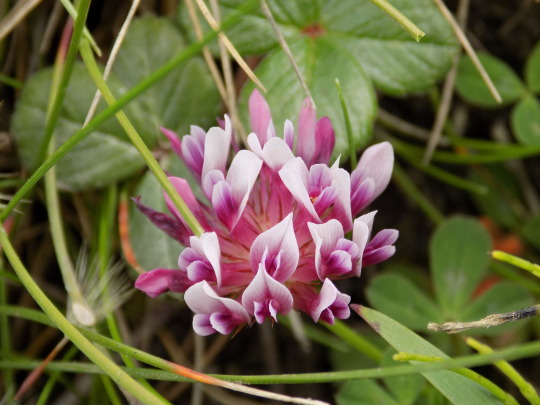
Pink springbank clovers are a tasty and vivid addition to a fresh salad.
"The U.S. Army created the Universal Edibility Test to help soldiers identify poisonous vs. edible plants while out in the field. The test is a standard in the U.S. Army Survival Field Manual ATP 3-50.21, and it appears in the SAS Survival Handbook written by former British Army officer and survival expert John Wisemen."
- From GreenBelly.co
❁❀✿✾
The "Universal Edibility Test" is, as the name suggests, a method for determining the safety of consuming a plant you are unfamiliar with. Here is a very good, simple explanation of the way test works, via Backpacker:
1. Separate the plant into its various parts—roots, stems, leaves, buds, and flowers. Focus on only one piece of the plant at a time.
2. Smell it. A strong, unpleasant odor is a bad sign, as is a musty or rotting odor. Keep a special lookout for pear- or almond-like scents, which can be evidence of cyanide.
3. Test for contact poisoning by placing a piece of the plant on your inner elbow or wrist for 8 hours. If your skin burns, itches, feels numb, or breaks out in a rash, wash off your skin and don’t eat the plant.
4. If the plant passes the skin test, prepare a small portion the way you plan to eat it (boiling is always a good bet).
5. Before taking a bite, touch the plant to your lips to test for burning or itching. If there’s no reaction after 15 minutes, take a small bite, chew it, and hold it in your mouth for 15 minutes. If the plant tastes very bitter or soapy, spit it out and wash out your mouth.
6. If there’s no reaction in your mouth, swallow the bite and wait 8 hours. If there’s no ill effect, you can assume this part of the plant is edible.
7. Repeat the test for other parts of the plant; some plants have both edible and inedible parts. Starting to feel sick? Time to bring it up.
❁❀✿✾
Plant Identification
I would also like to add that if you are unsure of the species of plant you are about to eat, make sure you keep some of it in case you need to have it identified in order to get treatment. Additionally, always have a friend or family member check on you after eating something unfamiliar or questionable so they can call an ambulance or poison control if necessary. Follow the instructions of medical personnel and do not try to induce vomiting or drink water or milk to dilute poison unless advised by a medical professional. Keep updated medical information in your wallet on your person for emergency personnel to reference.

A good identification photo contains as much detail about the plant as possible, including the shape/texture of the leaves, the flowers, stems, and fruit.
Of course, and as the article points out, the single best way to avoid poisoning is to make a positive ID on the plant before consuming it. Plant identification is a challenging skill, but one that is very fun to learn. Some plants look different depending on the season. Some look poisonous, but are perfectly safe. Some may just give you a stomachache or taste awful. Others might look gross, but taste quite good. I'll provide some examples of good eats that are common and easy to identify at the bottom of this article.
How should you go about identifying a plant, though? There are a lot of ways to do it. For my part, I recommend getting a second opinion as often as possible. Take a picture of every part of the plant; the leaves, flowers if there are any, and the roots. Take note of the color of the sap. The more mature a plant is, the easier it is to identify. Share the pictures on a platform such as iNaturalist to get opinions and identification assistance from experts in the field. You can also view thousands of pictures of plants, look up the species commonly found near you, and find out which plants are invasive and which are native to your area. Pl@ntNet is another similar platform. You can also download mobile apps to identify plants on the go. iNat has a particularly good one.
From there, it's pretty easy to Google the name of the plant + edibility. If the answer is 'yes', please make sure you confirm which parts of the plant are edible. It is common for some parts to be edible and for others to be inedible/poisonous, as with some nightshades (where the fruit or root is edible, but the leaves and stems are not; ex: potatoes, tomatoes). The USDA Natural Resources Conservation Service provides this very informative guide. Masterclass also provides a handy checklist for plant identification.
In general, to positively ID a plant with the most possible accuracy, you need to make a note/take a picture of these things:
The location and season in which you found the plant.
Any distinct characteristics on stalks and branches.
The size, shape, and arrangement of the leaves.
The characteristics of any fruits and flowers on the plant.
Any barbs or hairs on the plant, known as trichomes.
The root system, needed to determine if the plant grows from rhizomes, bulbs, or tubers.
Get a second and third opinion whenever possible. With time and practice, you'll start to notice the otherwise subtle differences between many kinds of plants, and you'll learn about some surprising relationships between them.
❁❀✿✾
Ethical Foraging Guidelines
Of course, just because we've found a tasty weed outside doesn't mean we should run out and pick every instance of it we find. There is an ethical--and, importantly, legal--way to forage. If we just go around picking every plant in the hopes of eating it, we're robbing wildlife of their meals. Many pollinating species of bees, beetles, and butterflies rely on specific plants for eating and hosting their eggs, so we need to minimize how much of that we take from them. The USDA NRCS also has a good guide for protecting pollinators when farming and landscaping, but the rules are a bit different when it comes to foraging, since we're going into their habitats and messing with things rather than the other way around.
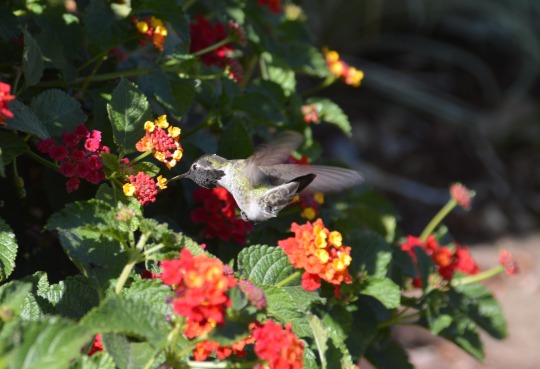
When foraging, it is important to be considerate of pollinators that help the plants we eat grow and propagate.
First and foremost, learn about your local environment. You can learn a lot about your area using this handy tool from the US Environmental Protection Agency.
Next, learn from the experts by asking staff at local regional and state parks about the legality and availability of foraging foods. Many have free educational events and classes that explore the subject and help you broaden your understanding of the environment in general. You can pick up a lot of good local wisdom from these events. If you do not have access to these services, however, you can also do some online classes here, here, and here.
Plan ahead. Chart a course and make sure you have everything you need. I always bring water, a small cooler, a pair of sharp, clean plant shears, a spade, a pocket knife, a small garbage bag for cleaning up litter, and an extra battery for my camera. Dress appropriately for the weather. Make sure your phone is charged and people know where you are and when to worry if they don't hear from you. Carrying bear spray on you doesn't hurt either, although do please remember to consider the direction of the wind so you don't accidentally spray yourself instead.
Do your due diligence in identifying the plant and investigating its status before just picking it. Ideally, you should choose a couple of species you already know to be edible and just pick those while you are out. It is wasteful and damaging to the environment to pick plants you don't recognize, only to find out you've pulled a rare native plant that certain species rely on to survive.
Harvest conservatively. Take only what you are certain you will eat, because every plant you take means many meals fewer will be available for local wildlife.
Leave the place better than you found it. If you notice trash, pick it up and dispose of it in the proper receptacles. Do not litter, do not attempt to alter the landscape (chopping down trees, burning or clearing "undesirable" plants, taking rocks, etc.), do not disturb dens or nests, and don't drive or walk off of the path. Soil compaction is a real thing.
Know the law regarding what is legal to pick and where it is legal to pick from. Some state and regional parks only allow foraging at certain times, and many do not allow it at all.
Devon Young goes into a little more detail on Learning Herbs.
❁❀✿✾
Transplanting Wild Edibles
When it comes to ethical foraging though, perhaps the single most ethical thing you can do is just grow these plants yourself. You can easily order seeds online that you can plant and grow in a pot or in your yard. Some of them are quite beautiful and most are very easy to grow. If you don't want to order them online, consider collecting seeds instead, but please remember to limit what you take so that the plants are able to properly propagate in the wild. You can learn how to harvest seeds from this article by Michigan State University.
I strongly encourage anybody interested in foraging to
It is also possible to transplant weeds. You may find a weed you like on a neighbor's lawn, and with their permission, you can dig it up and plant it in your own yard. Here's a cool video from Youtube that shows you how to do just that.
Avoid doing this with weeds from parks and other wild areas, however, because the further the plants have to travel before they are planted the less likely they are to survive, and that is wasteful. If you bring a pot and some soil, they may travel longer if you replant them right away.
Also, do be aware of the environment you are taking them from, as you obviously do not want to eat any plants that have been serving as a neighborhood dog or cat's latrine. A good place to take them from is your own backyard, provided you follow the above guidelines. Gathering and growing seeds wild circumvent this issue.
Always wash plants thoroughly before consumption. That will also help you avoid accidentally consuming any bugs.
❁❀✿✾
And that's it! That's how you can forage and eat adventurously without making a mess and disrupting your environment.
If you're from the east bay area/northern California, I can share some of my favorite weeds to eat.



Broadleaved Pepperweed
Bull Thistle
Cobwebby Thistle
Common Chickweed
Creeping Woodsorrel (limit due to oxalic acids)
Crane's Bill/Wild Geraniums
Fireweed
Hairy/Purple Vetch
Miner's Lettuce
Wild Mustard
Wild Radish
You can even find some recipes here.
Enjoy responsibly. ❁❀✿✾
#foraging#plants#weeds#garden#gardening#herbs#wild herbs#northern california#north america#plant identification#eat the weeds#pollinators#honeybees#bees#bumblebees#environmentalism#transplanting#free resources#nature photography#my photography#my articles#backpacking#camping#foraging guide#ethical foraging#wild edible plants#flowers#my writing#written by me
7 notes
·
View notes
Text
November 2022: Rainy Monday
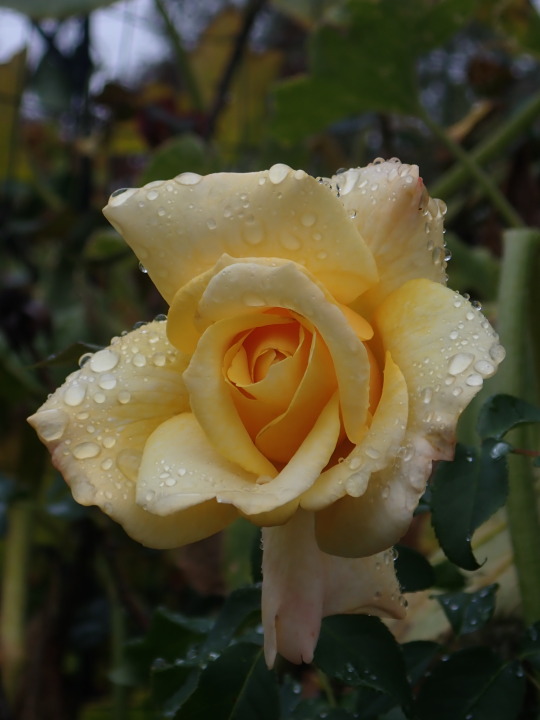
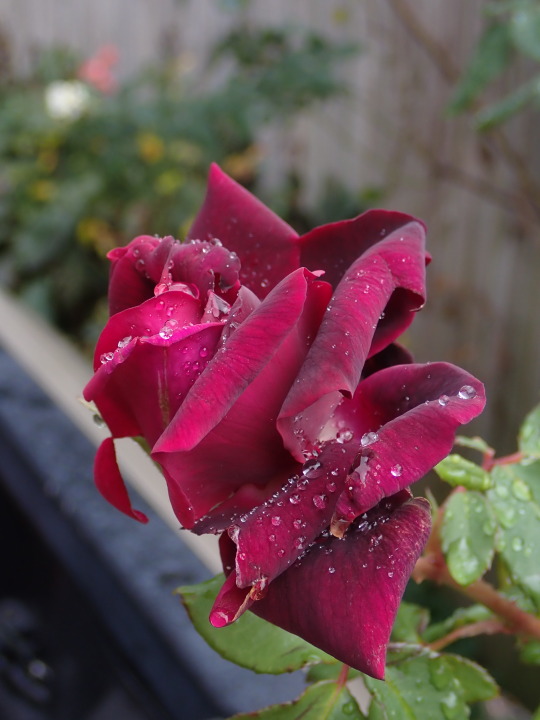
Sunday’s project was to yank out this knockout rose. This rose was at least 10 years old... sometimes gardening involves some hard & cruel decisions:
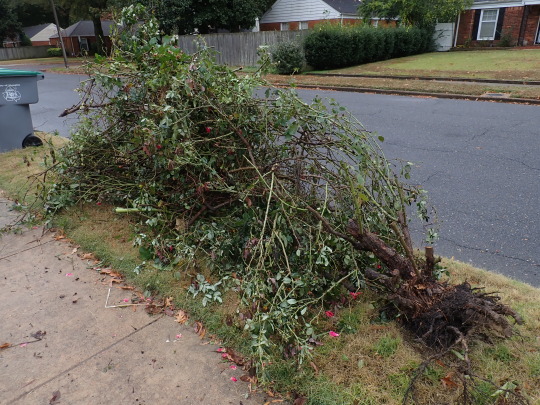
We replaced it with this chaste tree that came up from seed:
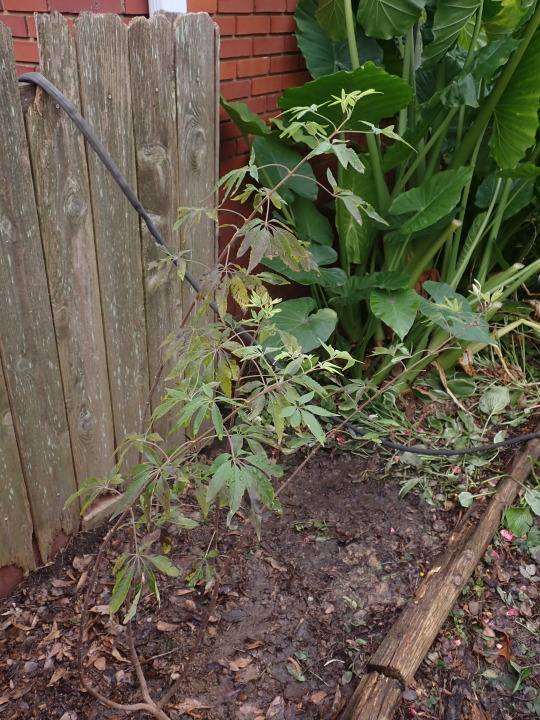
Today’s backyard garden. I was surprised to see a ripe tomato:

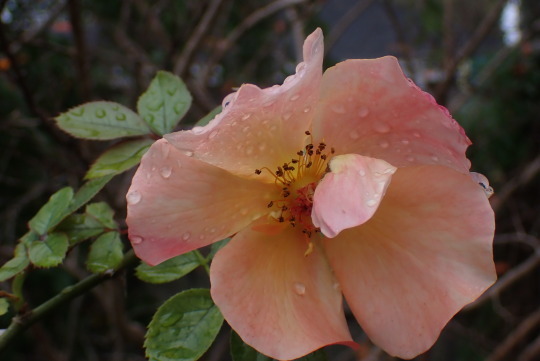
I mentioned in a previous post about pulling some green seedlings from Plot 420 & bringing them home. These are them. The one in the middle had been seriously gnawed in by the local rabbits or rodents that run amok in the fields around Plot 420:

Random brassica growing in the bird bath we turned into our sedum planter:

With the rain today, the only bees out were honeybees. The native Bumbles, Carpenters & all the assorted tiny bees stick close to home when it rains even when it is just the on & off drizzle that we got today:

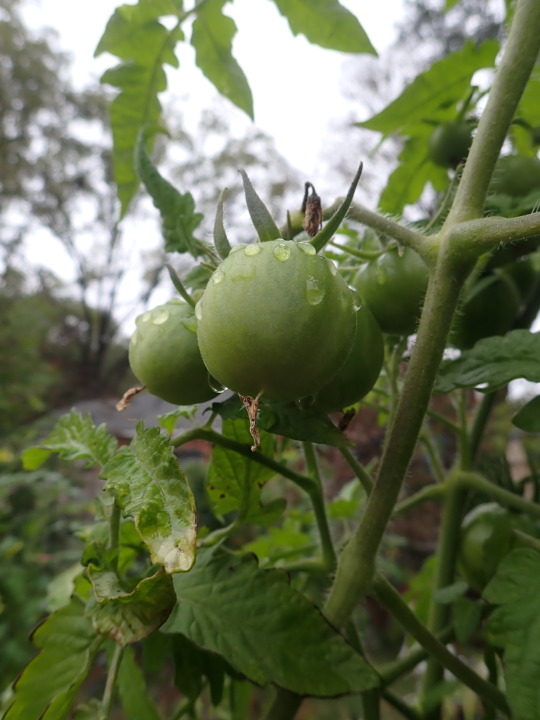
One of two curly leaf parsley plants that we grew from seed. This one is the most gorgeous. Look how tight those leaves are curled. You can’t buy that flavor in a store:
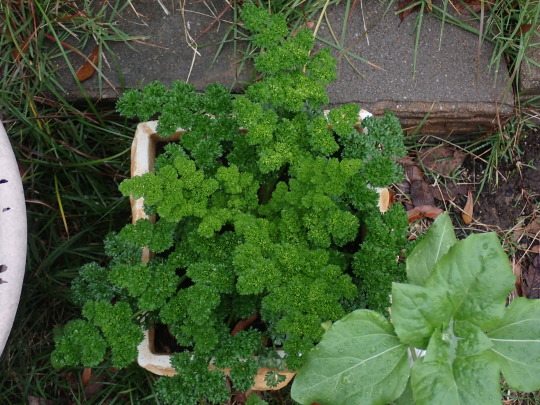
#garden#backyard garden#flowers#roses#yellow rose#red rose#knockout rose#homegrown vegetables#pole beans#tomato#cherry tomato#sweet million#transplanting#chaste tree#greens#seedlings#thai basil#honeybee#tomatoes#tigerella#parsley#curly leaf parsley#raindrops#rainy day#rainy monday#life in memphis
6 notes
·
View notes
Text
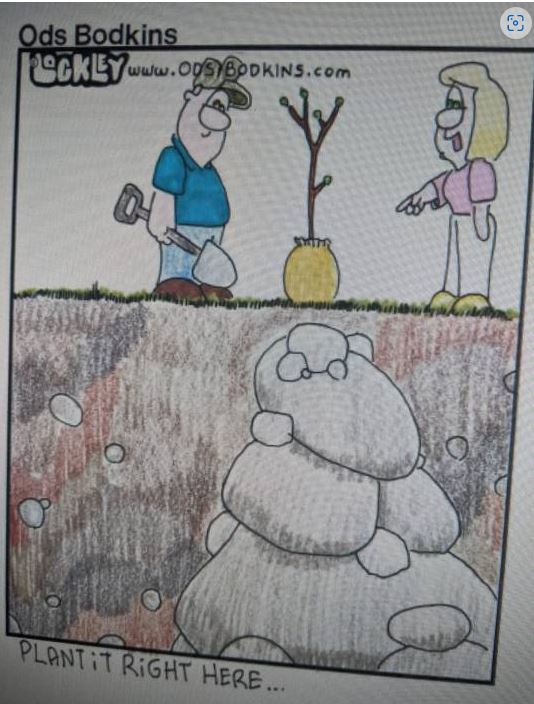
That about sums up my yard, built over a riverbed! :)
#gardener#gardens#gardening#gardenhumor#flower gardening#flowers#flowerbeds#beautiful flowers#transplanting#british columbia
2 notes
·
View notes
Text

3/21/24 ~ transplanted another tray today.
Why do I always over plant? 😅😅 send help
#indoor garden#sustainable gardening#container gardening#starting seeds#growing food#veganuary#grow organic#plant life#vegetable gardening#grow your own food#tiny tim tomatoes#transplanting
7 notes
·
View notes
Text
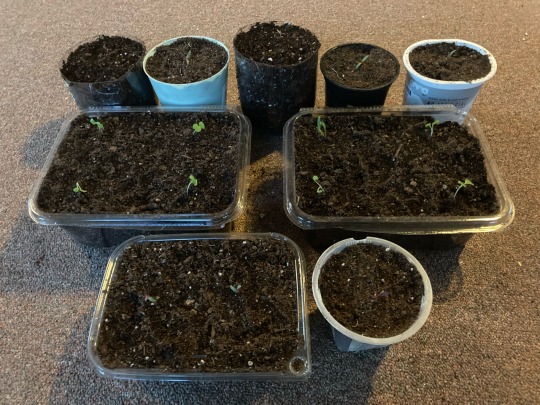
Some of my noodley babies in their new homes~ Most of them went back in the closet but I ran out of space in there for the last four singles so they’re chilling on the windowsill with my plants that are better established. I’m kind of running out of space everywhere though. I’m really looking forward to when our low temps get a little higher because that frees up our screened in porch for my “adult” plants, leaving my windowsills empty for my younger little dudes
#lettuce#mesclun#indoor gardening#gardening#plants#vegetables#transplanting#i want to name them all after pasta but i try not to get too attached to my lettuce#once my grow closet is done so much of this will be easier
2 notes
·
View notes
Text
youtube
Hello, everyone! Welcome back to Backroads Homesteading. I'm Ryan, and in today's video, we've got a lot to cover, from our adventurous chickens to important document signings, and even some unexpected weather challenges. So, grab a cup of tea, and let's dive into the happenings here at Backroads.
#BackroadsHomesteading#Homesteading#Chickens#PlantProtection#Transplanting#TeaLeaves#GojiBerries#Roofing#Gardening#DeerDeterrence#TreeRemoval#PropertyMaintenance#EquipmentMaintenance#Composting#GardenPlans#RuralLiving#SustainableLiving#FarmLife#HomesteadChallenges#YearRoundFarming#Youtube
0 notes
Text
How to Transplant Strawberries From The Mother Plant. https://youtu.be/Q5H4UlI9MxI?si=gnnY_b6kkXwKBbmz
youtube
0 notes